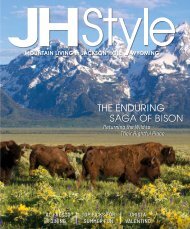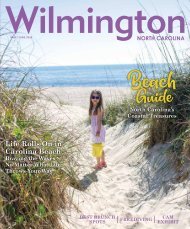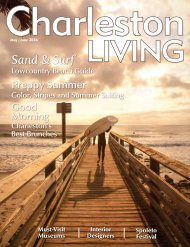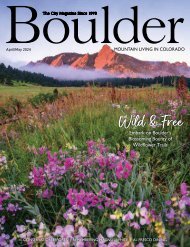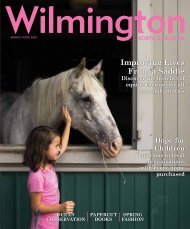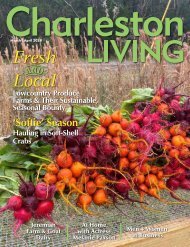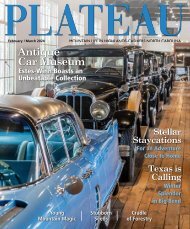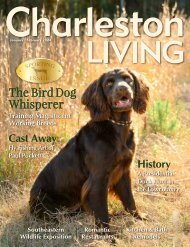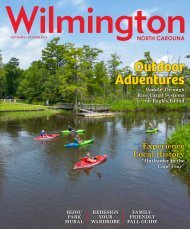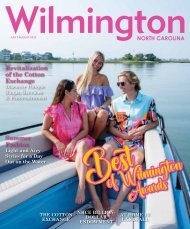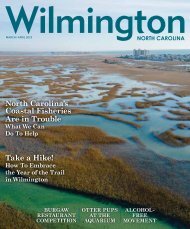Plateau Magazine June-July 2023
This issue we feature women entrepreneurs with locally run businesses and cowgirls who are protecting local animals. We also highlight protecting the land and fields that are important for bees and butterflies pollination. And for the foodies, check out our feature on the Highlands Tavern. Get outdoors with this issue, with our interview on legendary hiker Jennifer Pharr Davis.
This issue we feature women entrepreneurs with locally run businesses and cowgirls who are protecting local animals. We also highlight protecting the land and fields that are important for bees and butterflies pollination. And for the foodies, check out our feature on the Highlands Tavern. Get outdoors with this issue, with our interview on legendary hiker Jennifer Pharr Davis.
Create successful ePaper yourself
Turn your PDF publications into a flip-book with our unique Google optimized e-Paper software.
For the last 17 years, HCLT has been<br />
under the stalwart leadership of Dr. Gary<br />
Wein, a beloved figure on the plateau who<br />
has been integral to HCLT’s growth and<br />
success. From 2015 to 2021 alone, HCLT<br />
increased land protection by 38% but only<br />
increased its budget and operating expenses<br />
by 15%, which is wonderful but not sustainable.<br />
Thanks in large part to Dr. Wein, HCLT<br />
now protects over 3800 acres on the plateau<br />
with aspirations to protect much more.<br />
On <strong>June</strong> 30, however, Dr. Wein will step<br />
down, and HCLT will have a new Executive<br />
Director, Lance Hardin. An avid hiker<br />
and history enthusiast, Hardin has plans<br />
of his own. With a wealth of nonprofit experience,<br />
Hardin intends to focus on HCLT’s<br />
strategic conservation of the plateau’s<br />
iconic properties. “Our beloved natural<br />
resources face unprecedented challenges<br />
due to changing demographic, climate<br />
and economic forces,” he explains. “There<br />
has never been a more important time for<br />
HCLT’s mission.”<br />
At this passing of the torch, we wanted<br />
to reflect upon what HCLT means to the<br />
plateau. How exactly has it impacted<br />
our lives? To answer this question, we<br />
highlight some of the most ecologically<br />
significant properties currently under its<br />
stewardship. Understanding the value of<br />
these sites can help us look into the future<br />
and renew our commitment to support the<br />
organization that supports us.<br />
Keep in mind that HCLT is not a regulatory<br />
agency. It cannot bring enforcement<br />
actions against noncompliant actors. Rather,<br />
it acts as a perpetual steward of the<br />
land, which means it must acquire rights<br />
to that land first. HCLT does this in three<br />
ways: creation of conservation easements,<br />
donation or occasional purchase of lands<br />
in fee simple, and bequests. All of these<br />
require funding, a dedicated staff and<br />
committed volunteers. This is where we<br />
come in. As ordinary citizens and property<br />
owners, there is much we can do to support<br />
HCLT.<br />
McKinney Meadow<br />
Butterfly Weed<br />
(asclepias tuberosa),<br />
being pollinated by<br />
a carpenter bee, a<br />
native pollinator.<br />
Fritillary butterfly<br />
visiting a flowering<br />
Ironweed (Veronia<br />
noveboracensis)<br />
Grasshopper among<br />
Juncus and other<br />
herbaceous species in<br />
the wetland portion<br />
of McKinney Meadow.<br />
In the heart of downtown Cashiers, this<br />
stretch of land holds not only history but a<br />
biodiversity that has made it a designated<br />
stop on the Butterfly Highway, a statewide<br />
conservation restoration initiative that<br />
aims to restore native pollinator habitats<br />
to areas impacted by urbanization, land<br />
use change and agriculture.<br />
This site stands at the entrance to the historic<br />
107 corridor in Cashiers, home to three<br />
National Register of Historic Places properties:<br />
High Hampton, Church of the Good<br />
Shepherd and the Zachary-Tolbert House.<br />
It was for sale and likely would have been<br />
purchased for commercial development, but<br />
the community rallied around preservation<br />
efforts and raised money for its purchase.<br />
Historically, this property was the site of<br />
the McKinney Boarding House, where early<br />
19th century prominent figures like John C.<br />
Calhoun stayed when visiting the area. It is<br />
rumored that on one of Senator Calhoun’s<br />
visits, a travelling postman stopped in for<br />
the night only to find there were no beds.<br />
Not to be deterred, the postman turned to<br />
the Senator and said, “Move over thare old<br />
Horse, and let’s spoon.”<br />
Community icon Granny Allen, known for<br />
her generosity toward workmen, also lived<br />
on the property until her home was demolished<br />
in the early 1970s.<br />
But perhaps its greatest magic is in what<br />
it offers today. HCLT manages the property<br />
as a wildflower meadow, for which the site<br />
is particularly well-suited. Natural groundwater<br />
discharge has created a wetland that<br />
teems with life, and the land’s topographic<br />
characteristics, including impacts from its<br />
previous uses and plantings, have resulted<br />
in diverse vegetation. This network of native<br />
flowering plants, critical to HCLT’s restoration<br />
efforts, supports butterflies, bees,<br />
birds and other pollen and nectar dependent<br />
wildlife, which in turn support us.<br />
Our local native pollinators, including 174<br />
species of butterflies, 13 species of bumblebees<br />
and the Ruby-throated hummingbird,<br />
are responsible for pollinating important<br />
fruit and vegetable crops that are a vital<br />
link in the comprehensive food web. Unfortunately,<br />
these pollinators are threatened<br />
due to habitat loss, invasive plants and pesticides,<br />
which makes properties like McKinney<br />
Meadow invaluable. By protecting these<br />
pollinators and preserving their habitat, we<br />
are protecting our future.<br />
Edward Baker Preserve<br />
The Edward Baker Preserve is a 64-acre<br />
site on Laurel Knob Road with an intact<br />
second-growth forest and rudimentary<br />
trails. A second-growth forest is a forest<br />
or woodland area that has regenerated<br />
through largely natural processes after<br />
human-caused disturbances such as timber<br />
harvest or agricultural clearing or<br />
equivalently disruptive natural phenomena.<br />
These forests provide habitat for native<br />
<strong>June</strong>/<strong>July</strong> <strong>2023</strong> | 93



